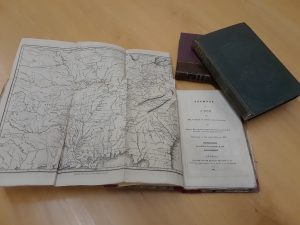Bicentennial of Schoolcraft’s Exploration of the Ozarks
 Tucked away on the shelves of Missouri State University Libraries Special Collections and Archives are three historical gems relating to the early history of the Ozarks. These books, written by Henry Rowe Schoolcraft, allow us to step back in time 200 years to the early exploration of Southern Missouri and Northern Arkansas.
Tucked away on the shelves of Missouri State University Libraries Special Collections and Archives are three historical gems relating to the early history of the Ozarks. These books, written by Henry Rowe Schoolcraft, allow us to step back in time 200 years to the early exploration of Southern Missouri and Northern Arkansas.
In 1819 the beautiful Ozark Mountains and surrounding area were largely unexplored wilderness, acquired in the Louisiana Purchase of 1803. Today, 2019, we celebrate the bicentennial of Henry Rowe Schoolcraft’s journey through the Ozarks, and the travelogues that bear his name.
Beginning November 6, 1818, in Potosi, Missouri, Schoolcraft, looking for lead ore to mine, first trekked to Steelville, on across the Meramec River, and then from the Salem Plateau to the Current River valley. Schoolcraft and his traveling companion, Levi Pettibone, continued to venture south from Salem toward what is today Licking, Missouri. From there, they journeyed on, spending 13 days traversing the North Fork of the White River.
Later Schoolcraft met two local settlers, William Holt and James Fisher, who led him to view the cavern known today as Smallin Civil War Cave. With Holt and Fisher serving as guides, Schoolcraft ventured to where Pearson Creek enters the James River, an area in present day Greene Country, east of the city limits of Springfield. Here, on January 2-4, 1819, Schoolcraft found lead ore suitable for mining.
Having accomplished his primary objective, Schoolcraft then continued south and east, entered what is today Northern Arkansas, returned through Southeast Missouri, and found his way home to Mine á Breton in Eastern Missouri.
Two years later, 1821, Schoolcraft published his journal, his record of his journey through the Ozark wilderness: the tall grasses of the prairies; the deer, elk, black bears, and buffalo; the rivers and their valleys; the caverns, and, most important to him, the opportunities for lead mining. The publication of his journal later brought him work with the federal government, but of more value to us today are his descriptions of early 1800s Ozarks captured in the pages.
Missouri State University Libraries Special Collections and Archives are pleased to own three of Schoolcraft’s books: a first edition (1821) of Schoolcraft’s Journal of a Tour into the Interior of Missouri and Arkansas, and a first edition (1819) of A View of the Lead Mines of Missouri.
Our most recent addition, donated by Lynn Cline, is an early edition (1853) of Scenes and Adventures in the Semi-Alpine Region of the Ozark Mountains of Missouri and Arkansas.
These volumes represent Missouri State University Libraries’ commitment to collecting the literature of Missouri and the Ozarks for the purpose of preserving local history and providing educational opportunities for our patrons.